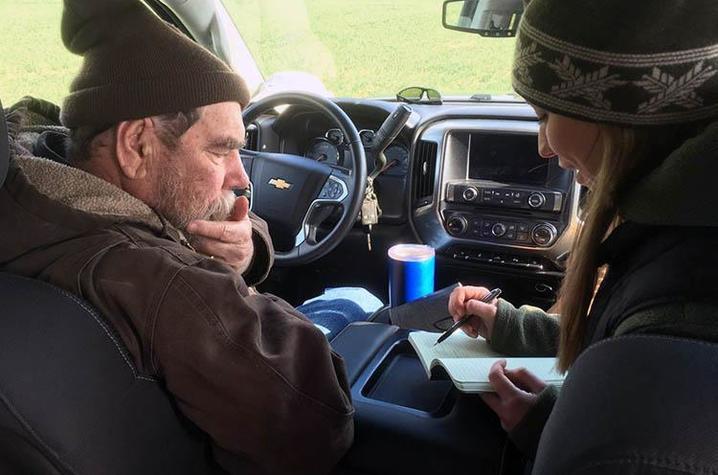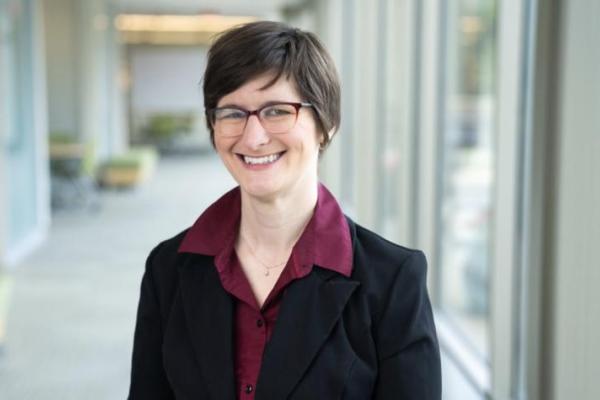Farmer, Researcher Partnerships Are Backbone of Agricultural Advances

Agriculture is advancing in fields across Kentucky thanks to farmers willing to take the time and share their land for research.
Scientists in the University of Kentucky College of Agriculture, Food and Environment engage with an extensive network of producers in all disciplines. The partnerships do not form overnight but over the course of numerous meetings, developing personal relationships and building mutual trust and respect.
“I am so proud of our researchers, who make the time and effort to go and listen to producers and see firsthand what their problems and questions are,” said Robert Houtz, associate dean for research and director of the Kentucky Agricultural Experiment Station. “Then together, they execute the experimentation and analyses that lead to useful and valuable solutions that increase the competitiveness of our state agricultural industry and demonstrate our commitment to the land-grant mission.”
Longtime Partners
Hardin County grain farmer Richard Preston is a longtime UK research partner and has hosted numerous on-farm research trials over the years.
“Research doesn’t do any good in an ivory tower,” Preston said. “You have to put it on farms to see if the lab and small-plot results hold true.”
Knowing Preston’s interest in optimizing his cover crops, two of his UK research partners, Josh McGrath and Chad Lee, connected him with soil scientist Hanna Poffenbarger shortly after she joined the UK faculty.
After a few conversations, Preston and Poffenbarger, along with UK graduate student Sam Leuthold, began an experiment to study the effects on corn yield that cover crops have when planted at various locations on Preston’s rolling farm. Their study used rye and a mixture of rye and crimson clover. It was funded by the U.S. Department of Agriculture’s Southern Sustainable Agriculture Research and Education, Kentucky Corn Growers Association, the college and environmental fellowships.
“On-farm studies are important to my overall research program, because the practical perspective of our farmer-cooperators keeps our research relevant. Richard’s experience with cover crops helped form this study,” Poffenbarger said. “On-farm studies also help scientists see soil processes occurring in working crop fields, which helps expand our understanding of the production system.”
Learning Opportunity
Preston is happy to not only host scientists’ projects but those of their graduate students.
“Students are the future of agriculture,” Preston said. “By letting them conduct research on our farms, we are helping develop future researchers and agronomists.”
For Leuthold, the project was a great opportunity to get hands-on experience for his master’s thesis. It also helped connect with a farmer on a personal level and understand his goals and constraints.
“Knowing the roles that time and economics play into producers’ management decisions gives us a better understanding of what farmers want to do versus what they can actually do. That helps us make our research relevant,” Leuthold said.
Leuthold hopes to use this experience, as he works toward a career bridging gaps between science and policy to make sustainable agriculture more accessible for more producers.
“The farmer interactions, stakeholder engagements and research this project provided me are things that I’m sure I will use again,” Leuthold said.
Through this study, the researchers saw higher cover crop growth and corn yields on low lying areas of the field. They also found cover crops increased soil moisture. Preston plans to do a variable-rate cover crop planting based on the results of this project.
“Producers are trying to improve our land, but we can’t do so without real science,” Preston said. “This is especially true with cover crops, because so much of the existing information about them doesn’t apply to every farm. That’s why on-farm research is so important.”
Finding Answers and Creating Better Stewards
Powell County goat producer Ben Burgher will be the first to admit agriculture is a new endeavor for him.
“I’m not a full-time farmer or the son of a farmer, but I inherited a farm and want to take care of it,” said Burgher, who is retired from Nestlé.
After hosting a countywide extension field day on his property, Burgher became connected with Jimmy Henning, UK forage extension specialist. For the past few years, they have worked on a research project designed to improve his hayfield, which had a lot of broomsedge. Broomsedge is an undesirable forage that can suggest the presence of a larger soil fertility issue. A soil test revealed the field was very low in potassium.
“I wanted to learn what would happen if we adequately fertilized the field with potassium,” Henning said. “Potassium deficiencies are becoming much more of a problem in forages. Potassium is removed in large quantities along with other nutrients in the hay at harvest, but oftentimes, producers only reapply nitrogen to the soil.”
Within a year of adding the correct amount of potassium to the soil, Burgher doubled the amount of hay he harvested from the plot.
“Jimmy was really great as far as explaining what he wanted to do and why,” Burgher said. “I plan to continue using the fertilizer combination he gave me from the study and also soil test to make sure the nutrients are needed.”
Henning has used results from the study to develop several popular press and grazing articles. He also plans to do a journal article.
“On-farm research is the most credible work we do,” Henning said. “Farmers see other farmers getting positive results, and they are far more likely to act than if they hear about something that happened on the experiment station.”
Extension Connectors
Many times, extension agents make connections between farmers and researchers. This was the case in Boyle County when horticulture extension agent Alexis Sheffield connected tomato growers Carly and Spencer Guinn to Rachel Rudolph, UK extension vegetable specialist.
Rudolph was in search of a tomato grower with a high tunnel who might be interested in branching out into cut flowers for a research project. Her research was evaluating the rotation of tomatoes with cut flowers in a high tunnel.
“On-farm research studies are critical for me to give growers practical information to improve their operations,” Rudolph said. “I do not want to create something that a grower cannot replicate. This study looked at whether growers could be successful growing both crops in the same year.”
The study was intriguing to the Guinns, who produce livestock, row crops, specialty grains, fruits and vegetables.
“We had grown tomatoes in the high tunnel for the past four years,” said Carly Guinn. “I had never grown flowers, but it was something I had always wanted to do.”
Not only did Sheffield connect the Guinns with Rudolph, but with her advanced knowledge in cut flower production, she contributed by providing valuable expertise on flower selection.
“I suggested flowers that were quick flowering, so the growers would have time to harvest the tomatoes and the flowers would have time to bloom before the first frost,” Sheffield said.
As is the case with many on-farm research projects, agents like Sheffield help growers regularly scout for issues.
“It is an ideal situation for agents to be involved in research projects, because we are right down the road from the growers,” Sheffield said. “We help relay information between growers and scientists on campus without the researchers having to make multiple trips to research sites that can be quite a distance away.”
Knowing that Sheffield was nearby made it easier for the Guinns to commit to the project, where they had to alter their regular planting dates so they could harvest the tomatoes earlier.
“We trusted her knowledge and knew she was going to be there to help us,” said Carly Guinn.
The project had some unforeseen benefits to the producers. Being connected to the researchers through the study was one way for the Guinns to gain more knowledge that will help them in their operation.
“Knowing Rachel had advanced knowledge in tomato production, we racked her brain and tried to gain as much knowledge as we could,” Carly Guinn said. “This year, we had a lack of airflow in the high tunnel, and she helped us figure it out.”
While the project required the producers to have good recordkeeping skills, the Guinns were used to that, because they keep records for their GAP certification. They learned things in this study that will help them long after the research has ended.
“Through this research project, we have a record of the bugs that were in the high tunnel and when and what their application thresholds were,” Spencer Guinn said. “This will help us make more informed application decisions in the future.”
The Guinns were able to harvest both crops, but they faced marketing challenges with their cut flowers. These challenges, exacerbated by COVID-19, made it difficult for them to break into a new market.
Rudolph remains optimistic about the project and plans to pursue it further. She and Sheffield have created how-to videos they plan to share with producers who are interested in growing the two crops.
On-farm research helps scientists and producers gain new knowledge that improves and advances agriculture. These valuable relationships between Kentucky farmers and UK researchers work toward the goal of more efficient and profitable Kentucky farms.
This material is based upon work that is supported by the National Institute of Food and Agriculture, U.S. Department of Agriculture, under award number 2018-38640-28417 through the Southern Sustainable Agriculture Research and Education program under subaward number 00002110. USDA is an equal opportunity employer and service provider. Any opinions, findings, conclusions, or recommendations expressed in this publication are those of the author(s) and do not necessarily reflect the view of the U.S. Department of Agriculture.
More from this series Graduate Research
Credits
Katie Pratt (Agricultural Communications)



